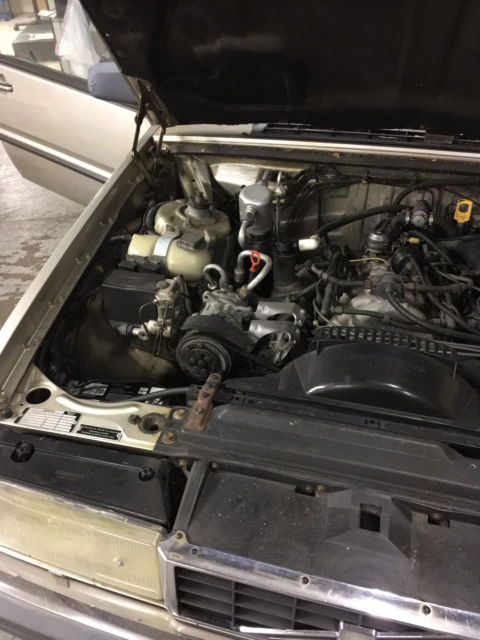1989 Volvo Bertone 780 - Collectible future classic
- Make: Volvo
- Model: 780
- SubModel: Bertone Coupe
- Type: Coupe
- Trim: Body and paint in excellent shape
- Year: 1989
- Mileage: 204,000
- VIN: YV1HA6929KD008711
- Color: Silver
- Engine size: 2.8 V6 PRV
- Number of cylinders: 6
- Power options: Air Conditioning, Power Windows, Power Seats
- Fuel: Gasoline
- Transmission: Automatic 4-Speed
- Drive type: RWD
- Interior color: Silver
- Drive side: Left-hand drive
- Safety options: Anti-Lock Brakes, Driver Airbag, Passenger Airbag
- Options: Cassette Player, CD Player, Leather Seats, Sunroof
- Vehicle Title: Clear
- Location: Babylon, New York, United States
Description
Future Collectible Classic 1989 Volvo 780Very unique and Stunningly beautiful Volvo Bertone 780
Hand made by Bertone Craftsman in Torino,Italy - This is actually the original paint
These cars are built like tanks and ride like cadillacs
Starts right up and runs well
Do your homework and due diligence:
There are 1988 and 1989 cars like this going for over $15,000 (check ebay)
The good news - These cars will only appreciate in value.
The honest truth - Full transperancy: This car is 28 years old so you will need to attend to these details to make it perfect:
There are a few dents and scratches, the headliner is up but will need attention,
The drivers leather seat and the electrical seats adjustments will need repair (motors good but contacts most likely dirty). Windshield is cracked (replacement available at Rock auto)
right front marker light lense, front air dam needs to be realigned but not replaced.
I also have a few parts to help you in your restoration
For your review and enjoyment - Article by Hemmings in 2012;
The 780 made its debut in March 1985 at the Geneva Motor Show. Production began in Bertone's new Grugliasco plant that September for the European market, but the first American-spec examples wouldn't arrive for another year, as 1987 models. Bob Austin, Volvo North America Corporation's former public relations manager, recalls the "positioning statement" they devised to market the new flagship: "The Volvo 780 is for successful people who appreciate stylish, limited-production European touring cars, yet value the safety and practicality of a Volvo. Sleek Bertone styling on the outside, sumptuous hand-stitched leather on the inside, and the strength of a Volvo. An exotic automobile for a practical consumer." This $34,785 two-door cost a startling $7,505 more than the next-most expensive 1987 Volvo, the 760 Turbo station wagon, but in addition to its unique body and sporty black cross-hatch grille, it had front and rear fog lamps, 15-spoke alloy wheels and an anti-theft alarm; inside, it featured comprehensive instrumentation, automatic climate control, a tilt-and-slide power moonroof, full leather upholstery (single or two-tone, depending on color choice) over heated eight-way power seats, genuine beech burl wood trim and a four-speaker cassette stereo with seven-band graphic equalizer. In its first year here, the car used Volvo's Constant Track rear suspension with a live rear axle located by longitudinal control arms and torque rods attached to a subframe; this system was supported by Boge Nivomat self-leveling shocks. While Europeans had the option of a turbo-diesel six, American customers got the 760's reengineered Peugeot-Renault-Volvo V-6, internally coded B280F. An updated-for-1987, more reliable version of the 262C's engine, this even-firing 2,849cc V-6 used a 91 x 73mm bore and stroke, a 9.5:1 compression ratio and Bosch LH-Jetronic 2.2 fuel injection to make 145hp at 5,100 RPM and 173-lbs.ft. of torque at 3,750 RPM. It was mated exclusively to a four-speed automatic gearbox for our market, although others could shift for themselves. This combination didn't make the 3,329-pound coupe a fire-breather, but allowed a 9.8-second 0-60 MPH time and a 115-MPH top speed. Volvo's typical emphasis on safety meant this four-seater got everything in the arsenal, including energy-absorbing safety cage construction, four-wheel disc brakes--the fronts ventilated--with anti-lock and split braking circuits, a driver's side airbag and knee bolster and front seat belt pre-tensioners. When the 780 returned for 1988--now costing $37,790--it gained the updated 760's redesigned rear suspension that tossed the live axle for a sophisticated "Multi-link" independent setup. This new design, its track two inches wider on the coupe than on the sedan, featured coil-over Nivomat shocks and offered lower unsprung weight for improved handling and ride. Also updated was the car's electronic climate control system. While performance fans were disappointed by the $37,790, V-6-powered 780's torque figure drop to 136-lbs.ft. at 2,750 RPM in 1989, they applauded the new, $38,975, 780 Turbo. Volvo's beloved "red block" B230FT, this four-cylinder displaced 2,316cc via its 96 x 80mm bore and stroke. With 8.7 compression, electronic fuel injection, a water-cooled turbocharger and air-to-air intercooler, as well as Volvo's new "Turbo +" boost control system, it made a heady 30hp and 51-lbs.ft. of torque more than its V-6 counterpart. Turbo + raised boost from 10.5 to 14 PSI, bumping the 760 Turbo's horsepower from 160 to 175. Setting the car apart visually were stylish multi-spoke wheels, an inch wider than standard at 15 x 7, although tire size remained 205/60HR-15. Changes on all 1989 780s were limited to "VOLVO" front fender badges (covering holes for Euro-market side markers) and memory glide front seatbacks that returned to their previous position after being tilted. A traditional Volvo chrome vertical-bar grille was fitted to some cars. The introduction of Volvo's "Generation 3" turbocharged four-cylinder engine for 1990 made the $39,950 780 Turbo even more powerful; a smaller, faster-spooling turbo coupled with breathing improvements pushed output to 188hp at 4,800 RPM and 206-lbs.ft. of torque at 3,900 RPM, making this 780 the most powerful Volvo built to date. The V-6 model, priced $1,215 less, shared the Turbo's new visor mirrors and its Multi-X wheels, although both cars' tires were downsized to 195/65HR-15s. Echoing the swan song of its Bertone predecessor, the 780 was re-named "Coupe" for 1991, its final model year, when it cost $41,945. All Coupes (forgoing the prior French accent) were Turbos, and they gained a limited-slip differential, larger (24mm, from 21mm) front anti-roll bar and new multi-link-compliant, 18mm rear anti-roll bar designed for the 760's replacement, the 940 SE. Inside, a new stereo system was teamed with an optional trunk-mounted six-disc CD changer, and a plaque bearing Nuccio Bertone's signature--in his trademark green ink--was mounted on the center console. While 780s outnumbered 262Cs in worldwide production (8,518 to 6,622) and the majority (estimated at roughly 5,700) were sold here, they remain exclusive cars, built with traditional craftsmanship to a standard, instead of a price. All offer Volvo's sturdy design, modern creature comforts, cross-country cruising ability for two couples (with a 14.7-cu.ft. trunk and 21-gallon fuel tank) and a conservative, crisp appearance that is distinctly 1980s Volvo. This exclusivity isn't reflected in their prices; the top book value on a turbocharged 780--considered most desirable by purists--is roughly $5,500, although low mileage, pristine examples will change hands between enthusiasts for double that figure. "These cars aren't expensive, but if you have an accident, you'll never get back what it's worth," warns Jan Nystrom, 1991 Coupe owner and editor of the Volvo Club of America's Rolling magazine. "Mechanically, they're as solid and easy to repair as any Volvo, but remember that not a single exterior panel or trim piece is shared with other Volvos. So be careful--if you think that a broken headlamp or crumpled fender isn't a big deal, you'll find almost no new body and trim parts are available, and those that are, are very expensive." Indeed, salvage yards are the only source for some 780 components. These were expensive cars when new, and some of the remaining examples have led pampered lives, so it pays to search for a garage-kept car with full service records. Whether V-6 or turbo four, the 780 represents the pinnacle of rear-wheel-drive Volvo luxury and exclusivity, and its collectible appeal will only increase as the years pass. SPECIFICATIONS Engines -- SOHC aluminum V-6, 2,849cc/SOHC cast-iron block and aluminum head four-cylinder, turbocharged and intercooled, 2,316cc
Horsepower -- 145/175-188 @ 5,100/5,400-4,800 RPM
Torque, lbs.-ft. -- 173-136/187-206 @ 3,750-2,750/2,900-3,900 RPM
Fuel system -- Bosch LH-Jetronic 2.2 electronic fuel injection
Transmission -- Four-speed automatic
0-60 MPH -- 9.8/8.5 seconds
Top speed -- 115/124 MPH
Length -- 88.7 inches
Width -- 68.9 inches
Height -- 55.1 inches
Wheelbase -- 109.1 inches
Curb weight -- 3,329-3,439 pounds
More Volvo classic cars for sale
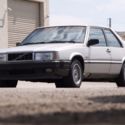 1989 Volvo 780 GLE Turbo Bertone Rare Coupe Collectible Low Miles Barn Yard Find
1989 Volvo 780 GLE Turbo Bertone Rare Coupe Collectible Low Miles Barn Yard Find
 1991 Volvo 780 Bertone Turbo Low Miles Barn Yard Find Collectible 740 760
1991 Volvo 780 Bertone Turbo Low Miles Barn Yard Find Collectible 740 760
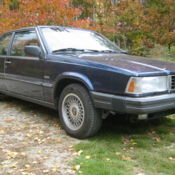 1989 Volvo 780 Bertone coupe Turbocharged B230F four cylinder volvo engine
1989 Volvo 780 Bertone coupe Turbocharged B230F four cylinder volvo engine
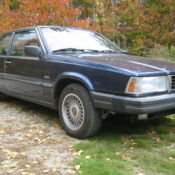 1989 Volvo 780 Bertone coupe Turbocharged B230FT four cylinder volvo engine
1989 Volvo 780 Bertone coupe Turbocharged B230FT four cylinder volvo engine
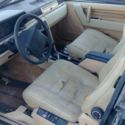 1989 Volvo 780 Bertone
1989 Volvo 780 Bertone
 Volvo 780 Bertone 1989
Volvo 780 Bertone 1989
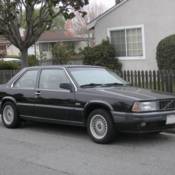 1989 VOLVO 780 COUPE BERTONE
1989 VOLVO 780 COUPE BERTONE
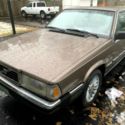 Volvo 780 Bertone for sale 1989
Volvo 780 Bertone for sale 1989
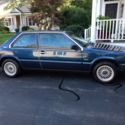 1989 Volvo 780 Bertone 2dr Coupe Turbo
1989 Volvo 780 Bertone 2dr Coupe Turbo
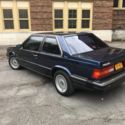 1989 Volvo 780 Bertone Turbo Rare
1989 Volvo 780 Bertone Turbo Rare
 1989 Volvo 780 GLE Turbo Bertone Rare Coupe Collectible Low Miles Barn Yard Find
1989 Volvo 780 GLE Turbo Bertone Rare Coupe Collectible Low Miles Barn Yard Find
Year: 1989
Mileage: 97,032
Mileage: 97,032
 1991 Volvo 780 Bertone Turbo Low Miles Barn Yard Find Collectible 740 760
1991 Volvo 780 Bertone Turbo Low Miles Barn Yard Find Collectible 740 760
Year: 1991
Mileage: 126,162
Mileage: 126,162
 1989 Volvo 780 Bertone coupe Turbocharged B230F four cylinder volvo engine
1989 Volvo 780 Bertone coupe Turbocharged B230F four cylinder volvo engine
Year: 1989
Mileage: 158,000
Mileage: 158,000
 1989 Volvo 780 Bertone coupe Turbocharged B230FT four cylinder volvo engine
1989 Volvo 780 Bertone coupe Turbocharged B230FT four cylinder volvo engine
Year: 1989
Mileage: 158,000
Mileage: 158,000
 1989 Volvo 780 Bertone
1989 Volvo 780 Bertone
Year: 1989
Mileage: 176295
Mileage: 176295
 Volvo 780 Bertone 1989
Volvo 780 Bertone 1989
Year: 1989
Mileage: 320693
Mileage: 320693
 1989 VOLVO 780 COUPE BERTONE
1989 VOLVO 780 COUPE BERTONE
Year: 1989
Mileage: 241,981
Mileage: 241,981
 Volvo 780 Bertone for sale 1989
Volvo 780 Bertone for sale 1989
Year: 1989
Mileage: 162555
Mileage: 162555
 1989 Volvo 780 Bertone 2dr Coupe Turbo
1989 Volvo 780 Bertone 2dr Coupe Turbo
Year: 1989
Mileage: 159395
Mileage: 159395
 1989 Volvo 780 Bertone Turbo Rare
1989 Volvo 780 Bertone Turbo Rare
Year: 1989
Mileage: 196,000
Mileage: 196,000










